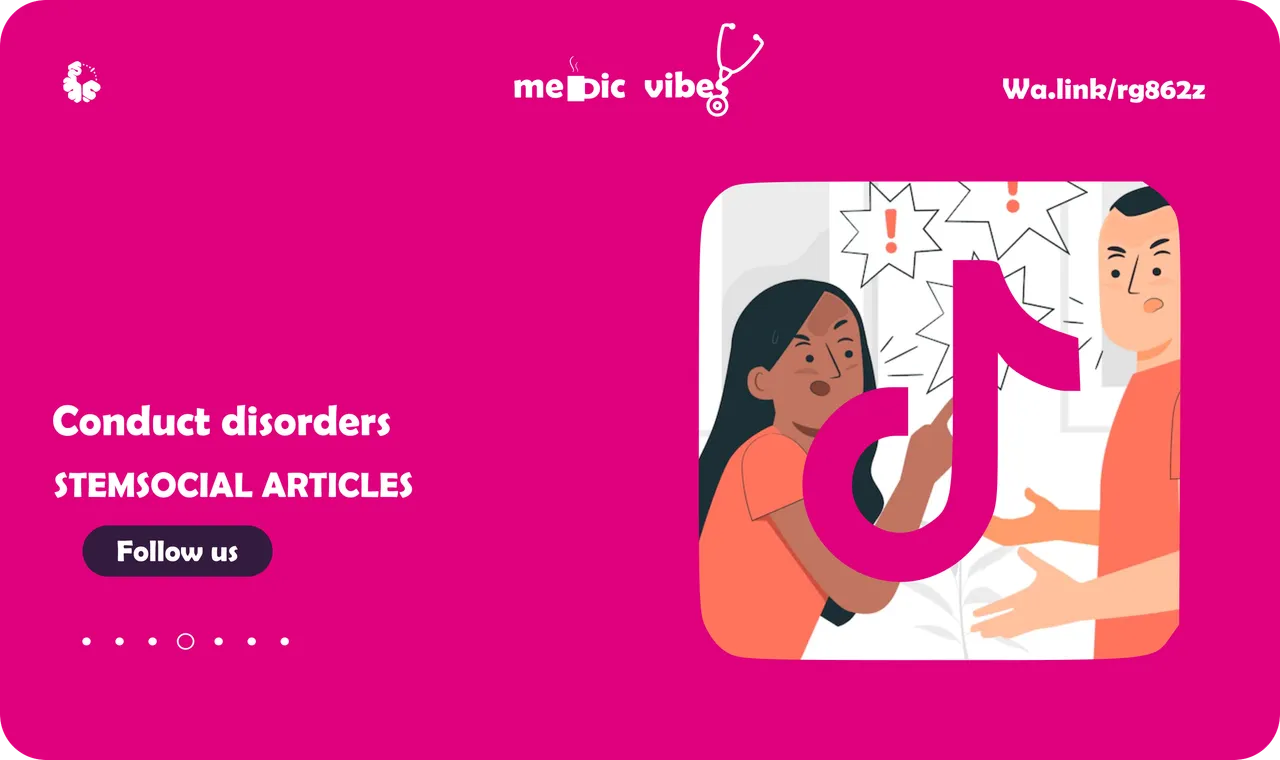
(Inkscape.org)[Inkscape.org]
In the last post, we saw how:
- Children who have oppositional defiant disorder tend to feel angry and the need to argue over a 6 month period.
- There is a relationship between trauma and conduct disorders.
- There are ways that this condition can be managed at home.
https://www.tiktok.com/@pseudo.analysis/video/7101414417849650478?is_from_webapp=1&sender_device=pc&web_id=7146615854787839493

(Inkscape.org)[Inkscape.org]
Welcome to Medic Vibes, where we discuss mental health disorders and make sense of them. Dr Ebingo Kigigha is a medical doctor (aspiring psychiatrist) and creative person (illustration and music). This has been our routine for four consecutive months. This month will be dedicated to Conduct disorder. In the first month, we discussed Depression, and in the subsequent month, anxiety. We just finished with Eating disorders.
In this post, we are looking at Tik Tok. To learn more just keep scrolling down. You can also skip to the key point of the post if you which or go to the conclusion to get the summary.

Personality disorders as a whole are mental health problems that are associated with changes in the way a person thinks, feels, and behaves toward other people.
In antisocial personality disorder, the patient's personality changes with impulsive responses, unreliable behaviour and criminality.
Those who have this disorder manipulate people and deceive people and do not care how others feel when they do.
This disorder is not an isolated presentation but comes in a myriad of ways. The different presentations can depend on the severity of the condition, in very severe cases they are more involved in criminal behaviour.
People who are considered to be psychopaths are thought to have a severe form of antisocial personality disorder.

Bad people and Conduct disorders(Reaction)

Image by storyset on Freepik
Alex Umbreanu who was clinically diagnosed with antisocial personality disorder and narcissistic personality disorder explained that.
In adults, they are typically not diagnosed with conduct disorders but they fall into this class of disorders when they do not meet the diagnostic criteria for antisocial personality disorder.
If you are diagnosed with personality disorder with antisocial traits it does not mean that you have an antisocial personality disorder and it is possible that the person may suffer from conduct disorder. Therefore those who have conduct disorder are typically children and adolescents.
The main difference between a child who is suffering from this disorder and a child who is simply being bad is dependent on the frequency and intensity of the bad behaviour.
It is important to note that this is what clinicians try to do as they gather history about the disorder.
Very well mind explains that conduct disorder is way more than just bad behaviour, and it is actually a mental health problem where a person (typically a child) exhibits traits that go against the laid down rules in society and often will offend others in ways against the law.
The disorder is more common in boys than in girls and it affects 3 in 100 school-aged children.
Children with conduct disorders need to be seen by a mental health professional. If these children are able to have the right therapy as soon as possible the chances of getting better are increased.
The features of conduct disorder are not a child just being bad, it is an issue of mental health concern and the behavioural problems these children face can make them unpopular among their peers and teachers in school. For a child to be diagnosed with this disorder there are certain features that go beyond just being a “bad child”. These features are shown by children with this disorder for a year (in case they show 3 of the features) or 6 months (if they show one of these features)
One of the categories of misconduct they can show is aggression towards people and animals. The way they do this is by oppressing, maltreating or bullying people. They have a higher proclivity to start fights and will use weapons to inflict harm on others. Their behaviour can be described as cruel and wicked and it may not be restricted to people as they can be wicked and cruel to animals too.
They carry out robberies and in the process physically harm others, they can sexually assault and rape others.
The second category of misconduct they can show is acts of property destruction such as fire setting. This is not to be confused with pyromania where the patient does so because of the impulse they feel to do so. Children who have conduct disorders usually set fire on purpose and do so premeditatively. Besides the use of fire, they may also vandalize property to make a point.
These children can also shoplift but when they do so they do not do so because they have kleptomania, they do so because they need the things they decided to steal as opposed to kleptomania where the stolen Items are usually not needed.
They may run away from home or out at night before the age of 13. They usually run away from home more than once.
The effects of conduct disorder on society are evident and part of the features of the condition, but what can be easy to miss are the effects this condition has on the child.
Children with this condition typically do not do well in school. The reason is that they have poorly behaved and it makes them unable to focus on school activities. They tend to be school dropouts.
Children who have conduct disorders get into problems with law enforcement, they abuse drugs and tend to be violent and in so doing they go against the law.
When a child suffers from conduct disorders they have low-quality relationships with those around them and children are not typically drawn to their behaviour. When they are severely affected they also find it hard to have close family members.
Females with conduct disorder tend to take risks sexually like having sex without protection and having multiple sexual partners.

Treating antisocial personality disorder
There is proof that a person with this disorder can get better even if the person does not have empathy for others but it will take extensive therapy.
There is always the risk that the person will have issues with management when there have been previous attempts at managing the patient.
But antisocial personality disorder is one of the most difficult types of personality disorders to treat.
Those who have this disorder sometimes start the therapy simply because they are mandated to by the court but do not go through with it.
There are several considerations to be made when a person has antisocial personality disorder such as the situation they are in, their age, their history with law enforcement and if they have started abusing drugs and alcohol.
Those who are close to the patient play an important part in how well they respond to therapy and how seriously they take their treatment.
For some patient other bodies need to be involved like the substance misuse services of the country, and social services.
Questions
- What did you learn about Conduct disorders?
Conclusion
- Those who have antisocial personality disorder will often fault the law.
- Conduct disorders is different from being a bad person.
- Treating antisocial personality disorder requires a long period of difficult treatment.

References
- Kaplan-Sadocks-Comprehensive-Textbook-Psychiatry
- Page demarcations made with Inkscape.org
- Healthline